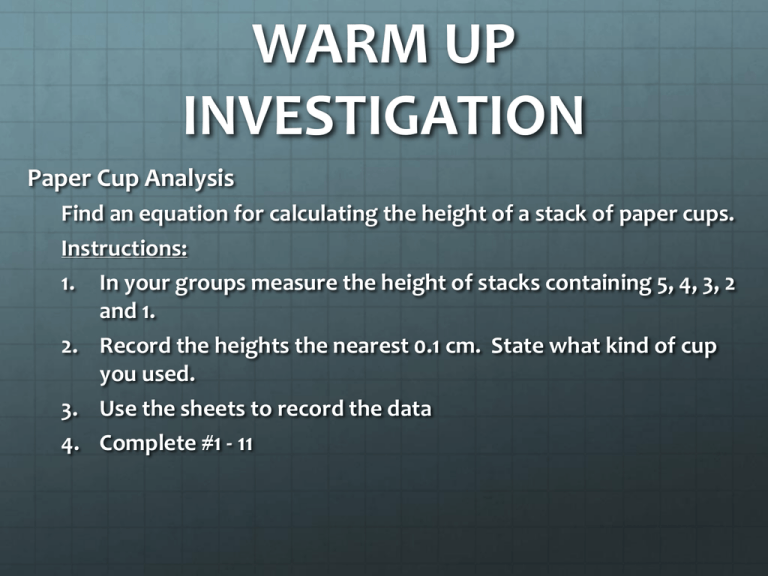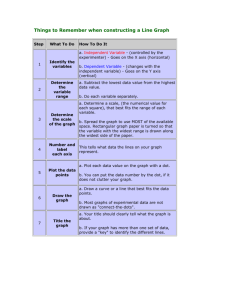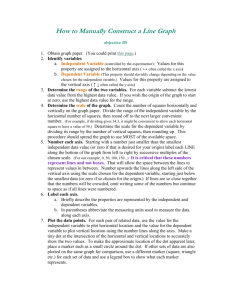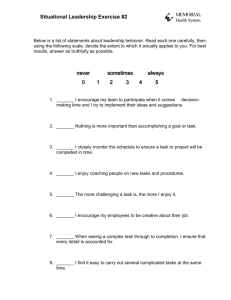Ch. 1.1 Functions
advertisement

WARM UP INVESTIGATION Paper Cup Analysis Find an equation for calculating the height of a stack of paper cups. Instructions: 1. In your groups measure the height of stacks containing 5, 4, 3, 2 and 1. 2. Record the heights the nearest 0.1 cm. State what kind of cup you used. 3. Use the sheets to record the data 4. Complete #1 - 11 FUNCTIONS OBJECTIVES Work with functions that are defined algebraically, numerically, or verbally IMPORTANT TERMS & CONCEPTS Function Expressing mathematical ideas graphically, algebraically, numerically & verbally. Mathematical model MATHEMATICAL OVERVIEW In Algebra 1 and 2 you studied linear, quadratic, exponential, power and other important functions. In this course, you will learn general properties that apply to all types of functions. You will learn this in four ways: Graphically Algebraically Numerically Verbally WHAT IS A FUNCTION? Function THE FOUR WAYS GRAPHICALLY: This is the graph of a quadratic function. The y-variable could represent the height of an arrow at various times, x, after its release into the air. For larger time values, the quadratic function shows y is negative. These values may or may not be reasonable in the real world. ALGEBRAICALLY: The equation of the function is y 4.9x2 20x 5 NUMERICALLY: The table shows corresponding x- and y- values that satisfy the equation of the function: x(s) y(m) 0 5.0 1 20.1 VERBALLY: When the variables in a function stand for things in the real world, the function is being used as 2 25.4 a mathematical model. The coefficients in the 3 20.9 2 equation of the function have a realy 4.9x 20x 5 world For meaning. example, the coefficient -4.9 is a constant that is a result of the gravitational acceleration, 20 is the initial velocity and 5 reflects the initial height of the arrow. MATHEMATICAL MODELS Functions that are used to make predictions and interpretations about something in the real world are called mathematical models. Temperature is the dependent variable because the temperature of the coffee depends on the time is has been cooling. Time is the independent variable. You cannot change time simply by changing coffee temperature. Always plot the independent variable on the horizontal axis and dependent variable on the vertical axis. GRAPHING TERMS The set of values the independent variable of a function can have are called domain. In the cup of coffee example, the domain is the set of non-negative numbers or x > 0. The set of values of the dependent variable corresponding to the domain is called the range of the function. If you don’t drink the coffee (which would end the domain) the range is the set of temperatures between 20 C and 90 C, including 90 degrees centigrade or 20 < x < 90. The horizontal line at 20 is called the asymptote. The graph gets arbitrarily close to the asymptote but never touches it. EXAMPLE The time it takes you to get home from a football game is related to how fast you drive. Sketch a reasonable graph showing how this time and speed are related. Give the domain and range of the function. SOLUTION: It seems reasonable to assume that the time it takes depends on the speed you drive. So you must plot time on the vertical axis and speed on the horizontal axis. SOLUTION It seems reasonable to assume that the time it takes depends on the speed you drive. So you must plot time on the vertical axis and speed on the horizontal axis. To see what the graph should look like, consider what happens to the time as the speed varies. Pick a speed value and plot a point for the corresponding time. The pick a faster speed. Because the time will be shorter, plot a point closer to the horizontal axis. SOLUTION For a slower speed, the time will be longer. Plot a point farther from the horizontal axis. Finally, connect the points with a smooth curve, because it is possible to drive at any speed within the speed limit. The graph never touches either axis, as the graph below shows. If speed were zero, you would never get home. The length of time would be infinite. Also no matter how fast you drive, it will always take you some time to get home. You cannot arrive home instantaneously. Domain: 0 ≤ speed ≤ speed limit Range: time ≥ minimum time at speed limit CHAPTER 1.1 ASSIGNMENTS Paper Cup Activity Concept Practice 1.1 Archery Problem: a – e Mortgage Problem: a – e









